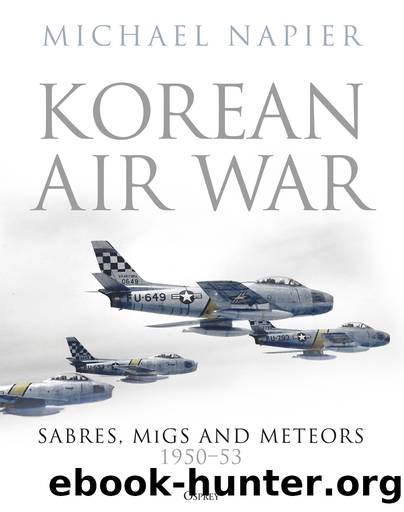Korean Air War by Michael Napier

Author:Michael Napier
Language: eng
Format: epub
Publisher: Bloomsbury
Published: 2020-03-15T00:00:00+00:00
Two four-ship flights of bomb-carrying F-84E Thunderjets of the 8th FBS/ 49th FBG set out for a mission over North Korea in late 1951. (USAFM)
The UNC Operation Killer had successfully regained the ground lost earlier to the CPVA and KPA by 6 March and had been superseded by Operation Ripper, which sought to recapture Seoul and advance to the Imjin River. The US 25th Division started to cross the Han River on 7 March, supported by over 570 sorties by 5th AF and 1st MAW aircraft. The effort was repeated the following day and 22 B-29s also struck a CPVA supply depot at Chunchon. Seoul was recaptured for the second time on 14 March, and nine days later, to cut off retreating CPVA forces, the US 187 Airborne Regiment carried out a parachute assault to capture the town of Munsan, a chokepoint where the road between Seoul and Kaesong crossed the Imjin River. The area around the drop zone was worked over by 56 B-26s from the 3rd BG and 452nd BG before nearly 3,500 paratroopers were delivered by a fleet of 72 C-119 Flying Boxcar and 48 Curtiss C-46 Commando transport aircraft. Once the troops were on the ground, CAS was provided by a force of 31 F-51s, 50 F-80s and 31 F-84s.
On the same day, the FEAF B-29s revisited Kogunyong, but this time they were escorted by a sizeable force of Sabres and the 12 MiG-15s which were scrambled to intercept the bombers were unable to penetrate the escort screen. Perhaps emboldened by this success, the FEAF sent its B-29s to the Yalu bridges on 29 and 30 March. On each day some 30 bombers were supported by a high cover screen of F-86s and close escort of F-80s from the 8th FBG and 49th FBG. Once again, the escorts managed to fend off most of the MiG-15 attacks, but even so one B-29 was lost on 29 March and another seriously damaged the following day.
By the end of March, the battle lines ran from the Imjin River in the west to the Hwachon Reservoir in the centre of the country, and then to Yangyang on the east coast. Naval aircraft had flown armed reconnaissance and CAS sorties throughout the month. On the east coast, the Panthers of TF77 were employed in the armed reconnaissance role, combing the highways and railway lines between Wonsan and Songjin (Gimchaek), hunting railway trains, vehicles and supply dumps and also bombing the bridges. On the west coast, the same tasks were performed over Chinnampo and the Ongjin Peninsula by Sea Furies and Fireflies from HMS Theseus until they were relieved in TF95 by the Corsairs of USS Bataan on 1 April. Meanwhile, the Corsairs and Skyraiders from USS Princeton and USS Boxer were dedicated to CAS sorties. The F-51, F-80 and F-84 units were busy, too, with armed reconnaissance and CAS missions every day. The weapon of choice for these roles was still napalm because it was very effective against area targets without needing to be dropped accurately.
Download
This site does not store any files on its server. We only index and link to content provided by other sites. Please contact the content providers to delete copyright contents if any and email us, we'll remove relevant links or contents immediately.
| Automotive | Engineering |
| Transportation |
Whiskies Galore by Ian Buxton(40331)
Introduction to Aircraft Design (Cambridge Aerospace Series) by John P. Fielding(32338)
Small Unmanned Fixed-wing Aircraft Design by Andrew J. Keane Andras Sobester James P. Scanlan & András Sóbester & James P. Scanlan(32141)
Craft Beer for the Homebrewer by Michael Agnew(17446)
Turbulence by E. J. Noyes(7039)
The Complete Stick Figure Physics Tutorials by Allen Sarah(6638)
Kaplan MCAT General Chemistry Review by Kaplan(6053)
The Thirst by Nesbo Jo(5785)
Bad Blood by John Carreyrou(5769)
Learning SQL by Alan Beaulieu(5411)
Weapons of Math Destruction by Cathy O'Neil(5036)
Man-made Catastrophes and Risk Information Concealment by Dmitry Chernov & Didier Sornette(4735)
iGen by Jean M. Twenge(4702)
Digital Minimalism by Cal Newport;(4540)
Life 3.0: Being Human in the Age of Artificial Intelligence by Tegmark Max(4507)
Audition by Ryu Murakami(4099)
1,001 ASVAB Practice Questions For Dummies by Powers Rod(4038)
Electronic Devices & Circuits by Jacob Millman & Christos C. Halkias(4027)
Pale Blue Dot by Carl Sagan(4001)
